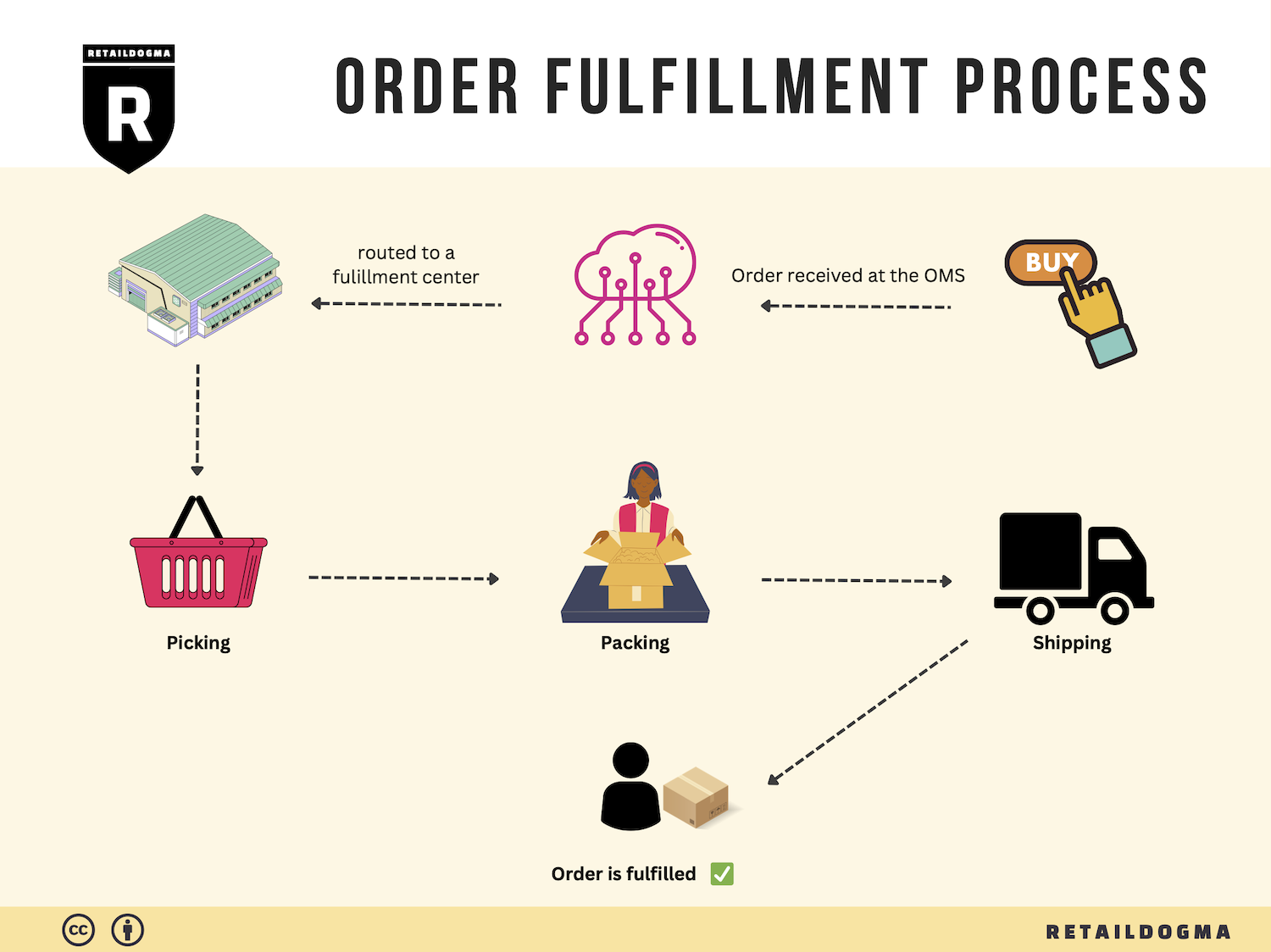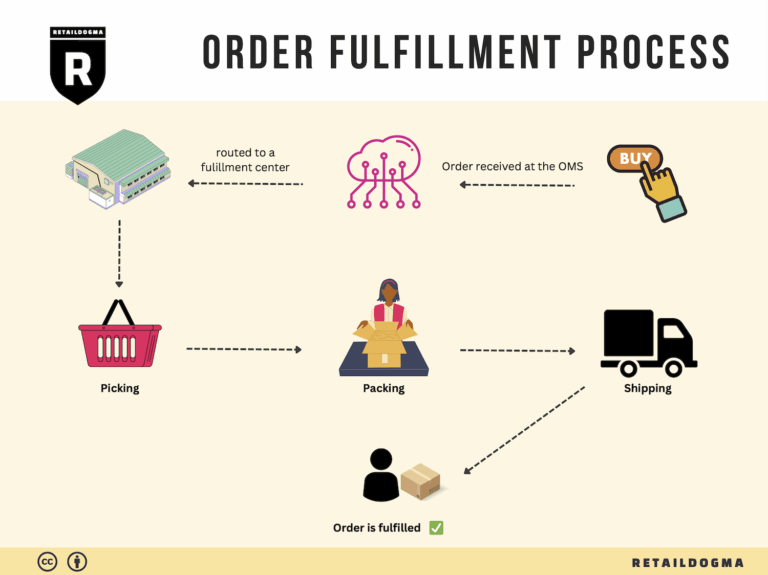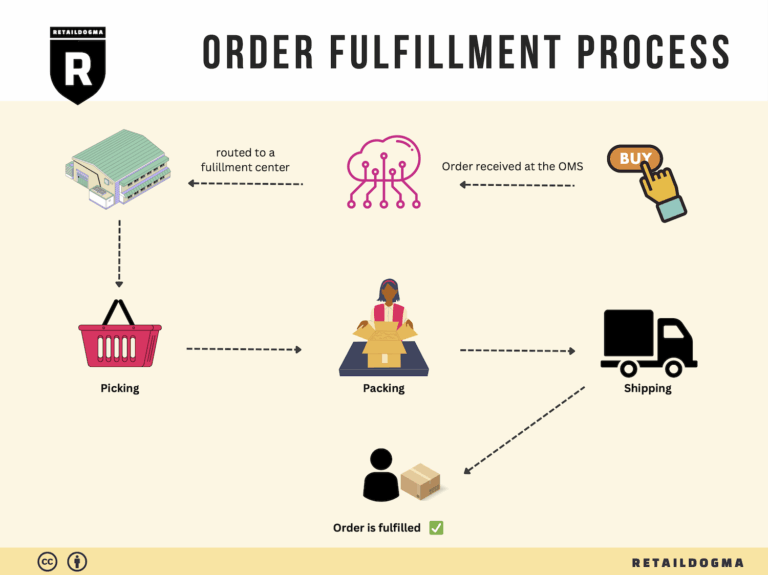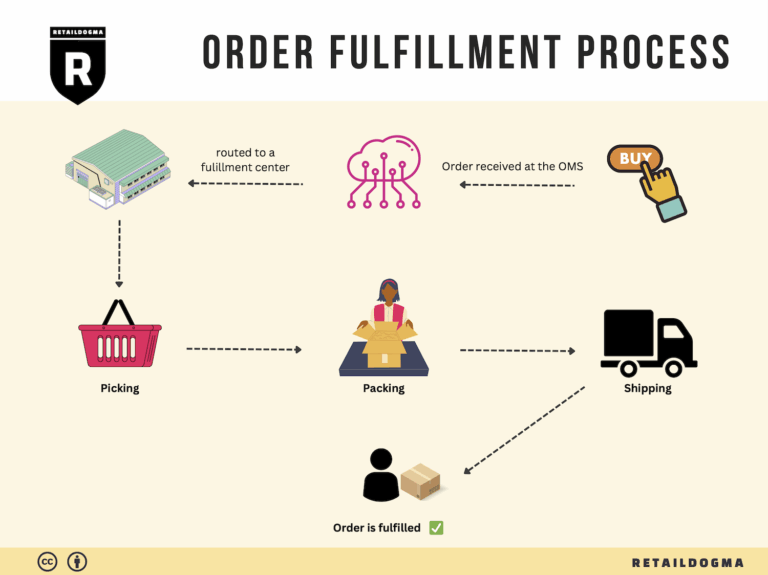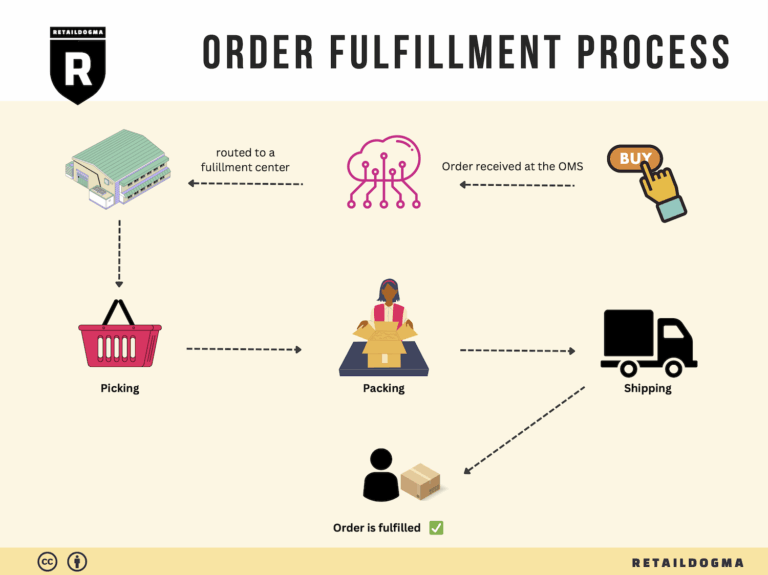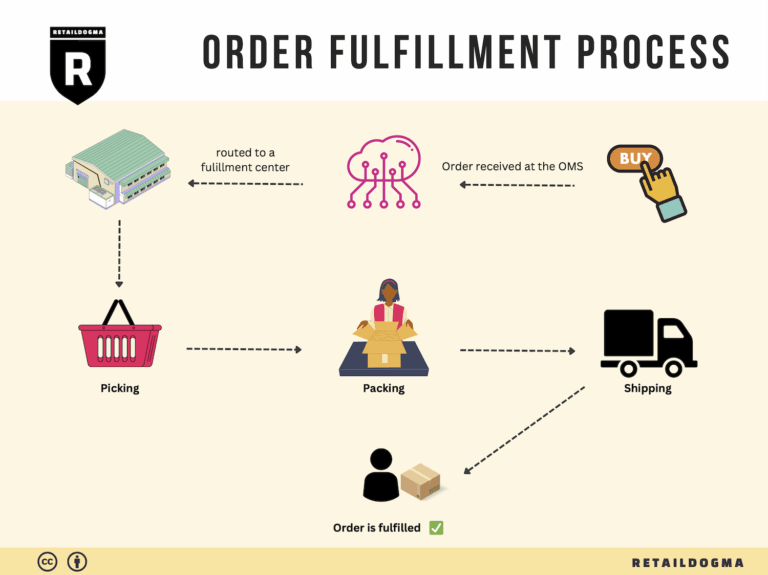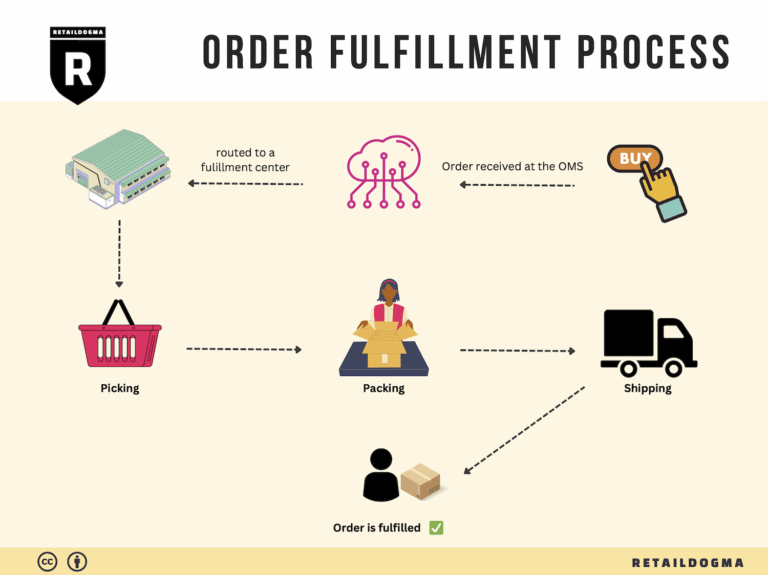How Order Fulfillment Works: A Step-by-Step Guide for Businesses
What is E-commerce Fulfillment? An Introduction for Growing Businesses
Understanding the Fulfillment Challenge
As an e-commerce business owner, you’ve likely experienced the frustration of managing packing and shipping orders. What starts as an exciting venture can quickly turn into a logistical nightmare. As your sales grow, so does the complexity of fulfilling customer orders efficiently. The pressure to deliver products quickly and accurately can overwhelm even the most dedicated entrepreneurs, diverting your attention from scaling your business to merely keeping up with order demands.
At its core, e-commerce fulfillment is the process of getting a product from your inventory to your customer’s doorstep. This involves a series of steps, including receiving inventory, storing it, picking and packing orders, and ultimately shipping them out. However, the fulfillment landscape is not one-size-fits-all; various models exist to cater to different business needs, which can significantly impact your operational efficiency.
Exploring Fulfillment Models
In this guide, we will delve into the different fulfillment models available to growing businesses, such as Third-Party Logistics (3PL) and Fulfillment by Amazon (FBA). Each model offers distinct advantages and drawbacks, and understanding these can help you determine which approach aligns best with your business goals.
Core Services of Fulfillment
We will also cover the core services that fulfillment partners typically offer, including inventory management, order processing, shipping, and returns handling. Knowing what to expect from a fulfillment partner is crucial for ensuring that your operations run smoothly and that your customers receive their orders on time.
Choosing the Right Partner
Selecting the right fulfillment partner can make or break your logistics strategy. This guide will provide practical tips on evaluating potential partners based on their capabilities, technology, and customer service, ensuring you make an informed decision.
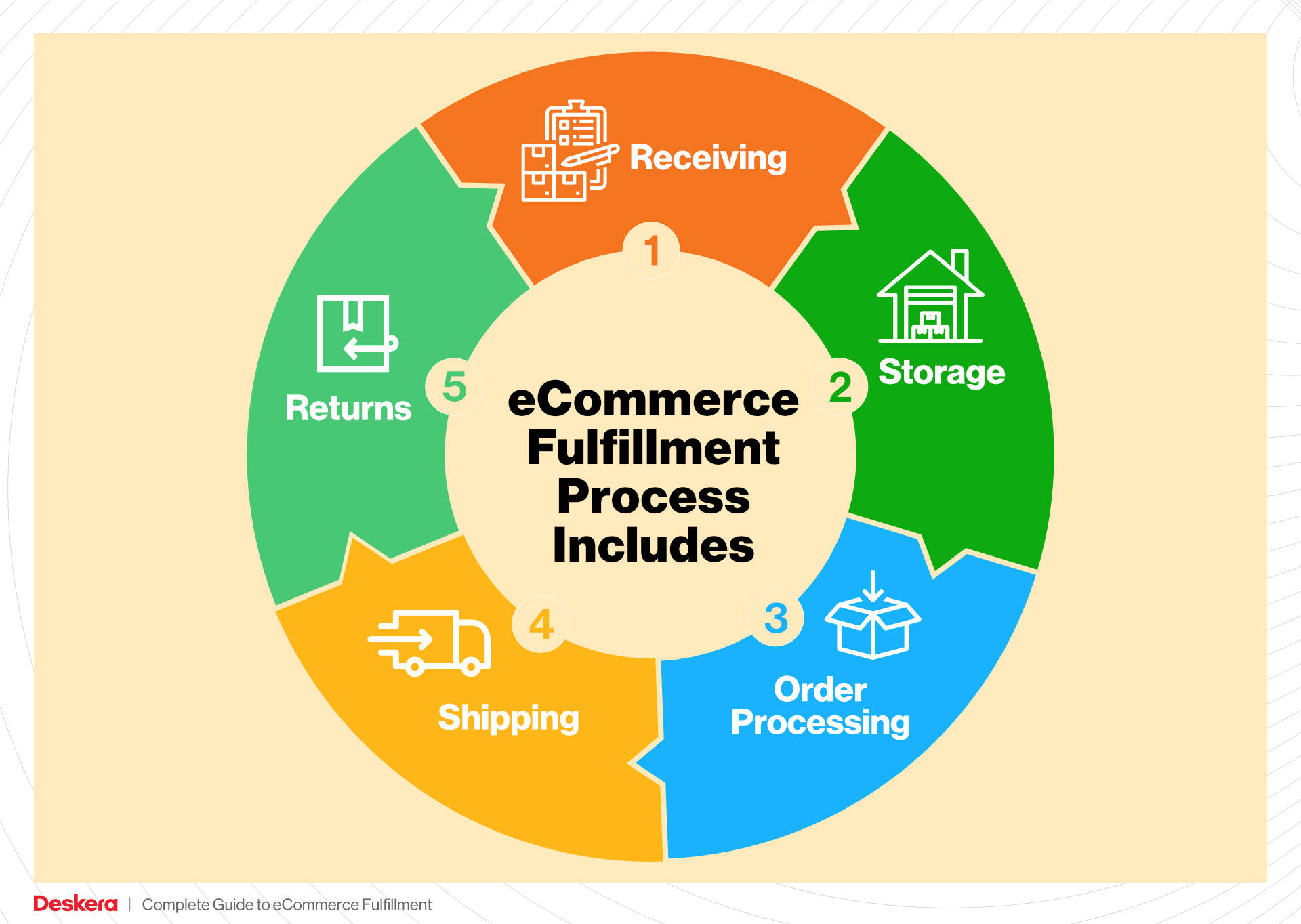
Understanding Pricing Structures
Finally, we will explore the various pricing structures associated with fulfillment services. Understanding these costs will help you budget effectively and avoid any hidden fees that could impact your bottom line.
Empowering Smart Logistics Decisions
The ultimate goal of this guide is to empower your business to make smart, informed decisions about your logistics strategy. By understanding the intricacies of e-commerce fulfillment, you can streamline your operations, enhance customer satisfaction, and focus on what you do best: growing your business. Let’s dive in and transform your fulfillment process into a competitive advantage.
What You’ll Learn In This Guide
- What is E-commerce Fulfillment? An Introduction for Growing Businesses
- The Order Fulfillment Process: From ‘Buy’ Button to Customer’s Door
- Comparing Fulfillment Models: In-House vs. 3PL vs. Dropshipping
- A Deep Dive into Amazon FBA: Pros, Cons, and Who It’s For
- Core Services Offered by Fulfillment Centers
- How to Choose a Fulfillment Partner: A 6-Point Checklist
- Understanding Fulfillment Pricing: A Breakdown of Common Fees
- Frequently Asked Questions (FAQs) about Fulfillment
- Conclusion: Is Outsourcing Fulfillment the Right Move for Your Business?
- Important Disclaimer
The Order Fulfillment Process: From ‘Buy’ Button to Customer’s Door
1. Receiving Inventory
The order fulfillment process begins with receiving inventory at the fulfillment center. This step involves the intake of products from suppliers or manufacturers into the warehouse. Upon arrival, goods are unloaded, and each item is checked against purchase orders to ensure accuracy in quantity and quality. This process often involves barcoding or labeling items with a unique Stock Keeping Unit (SKU), which facilitates tracking throughout the supply chain.
Receiving inventory is crucial because it sets the foundation for the entire fulfillment operation. Accurate receiving ensures that the right products are available for order processing, reducing the risk of stockouts or overstock situations. Furthermore, efficient receiving practices can help minimize discrepancies that may lead to customer dissatisfaction.
2. Warehouse Storage
Once the inventory has been received and verified, the next step is warehouse storage. This involves organizing and storing products in designated areas within the fulfillment center. Effective storage solutions can include shelving, pallet racking, and bins, all designed to optimize space and accessibility.
The importance of this step lies in its impact on order efficiency. Properly organized storage enables quick access to products, reducing the time required for order picking. Businesses often use Warehouse Management Systems (WMS) to track inventory locations and movements, ensuring that items can be retrieved swiftly when orders are placed. Key terms associated with this step include ABC analysis, which categorizes inventory based on importance and turnover rates, allowing for strategic placement and management.
3. Order Picking
The third step in the order fulfillment process is order picking, where items are selected from storage based on customer orders. When an order is received, warehouse staff use pick lists—documents or digital tools detailing which items and quantities to retrieve—to gather the necessary products from various locations within the warehouse.

Order picking is a pivotal phase because it directly affects order accuracy and fulfillment speed. The efficiency of this step can significantly influence customer satisfaction; errors in picking can lead to wrong items being shipped, resulting in returns and additional costs. To enhance picking efficiency, businesses may employ methods such as batch picking (picking multiple orders at once) or zone picking (assigning specific areas to individual pickers).
4. Order Packing
After items are picked, they move to the order packing stage. This process involves securely packaging the selected products for shipment. Proper packing includes choosing the right box size, using protective materials to prevent damage during transit, and including packing slips or invoices.
The significance of order packing cannot be overstated. It not only protects the items but also presents a professional image to the customer, which can enhance brand loyalty. Efficient packing processes can reduce shipping costs and improve delivery times. Key terms related to this step include dimensional weight pricing, which considers package size in addition to weight when calculating shipping costs. Businesses should invest in training staff on packing best practices and consider automation tools to streamline this process.
5. Shipping & Delivery
The final step in the order fulfillment process is shipping and delivery. Once orders are packed, they are labeled and prepared for dispatch. This stage involves selecting appropriate carriers based on factors such as cost, delivery speed, and destination. Packages are then transported to distribution points, whether directly to customers or to regional distribution centers.
Shipping and delivery are critical as they represent the last interaction a customer has with a business during the order fulfillment process. Timely and accurate delivery can significantly influence customer satisfaction and repeat purchases. Businesses often utilize tracking systems to provide customers with real-time updates on their order status. Key terms related to this stage include last-mile delivery, which refers to the final leg of the shipping journey to the customer’s doorstep, often the most complex and costly part of logistics.
By understanding and optimizing each step of the order fulfillment process, e-commerce businesses can enhance their operational efficiency, improve customer satisfaction, and ultimately drive growth.
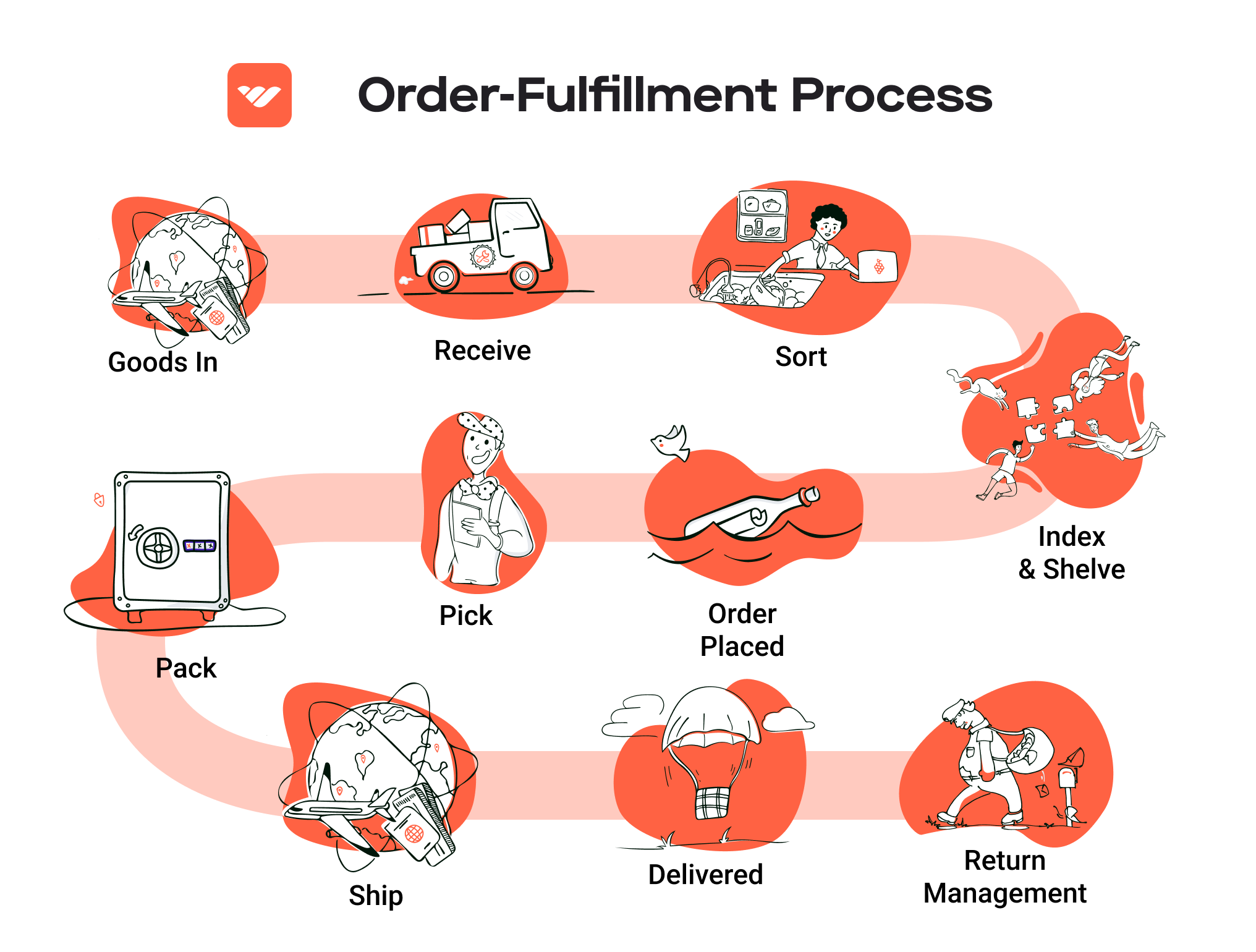
Comparing Fulfillment Models: In-House vs. 3PL vs. Dropshipping
Fulfillment Model Comparison Table
| Model | Who Handles Inventory | Best For (Business Stage) | Key Advantage | Key Disadvantage |
|---|---|---|---|---|
| In-House Fulfillment | The business itself | Established businesses | Greater control over operations | High overhead and operational complexity |
| Third-Party Logistics (3PL) | Third-party providers | Growing businesses | Scalability and expertise | Less control and potential for communication issues |
| Dropshipping | Suppliers | Startups and small businesses | Low upfront investment | Lower margins and dependency on suppliers |
In-House Fulfillment
In-house fulfillment refers to the model where a business manages its own inventory and order fulfillment processes. This approach often involves maintaining a dedicated warehouse or storage facility where products are stored, picked, packed, and shipped. For established businesses that have achieved a certain level of sales volume, in-house fulfillment offers significant control over the entire logistics process, allowing for tailored operations that align closely with the company’s brand and customer service standards. Businesses can implement customized packaging, streamline shipping processes, and ensure quality control directly. However, this model comes with its own challenges, including the requirement for significant capital investment in infrastructure, labor, and technology. Additionally, businesses must manage the complexities of logistics, including inventory management, warehousing costs, and shipping logistics, which can become overwhelming as the business scales.
Third-Party Logistics (3PL)
Third-party logistics (3PL) providers offer a comprehensive solution for businesses looking to outsource their fulfillment processes. In this model, a business partners with a logistics company that specializes in warehousing, inventory management, and distribution. 3PL providers allow growing businesses to leverage their expertise and infrastructure without the need for significant upfront investment in warehouse space or logistics technology. This model is particularly advantageous for businesses experiencing rapid growth or seasonal fluctuations in demand, as 3PLs provide scalability and flexibility. They often have established shipping networks and can negotiate better rates with carriers due to the volume of shipments they handle. However, a key disadvantage of using a 3PL is the potential loss of control over the fulfillment process, which can lead to issues with communication, order accuracy, and brand representation. Businesses must also ensure that they choose a reliable partner, as any failure on the 3PL’s part can directly impact customer satisfaction.
Dropshipping
Dropshipping is a fulfillment model where the retailer does not keep products in stock but instead transfers customer orders and shipment details to a manufacturer, wholesaler, or another retailer, who then ships the products directly to the customer. This model is particularly popular among startups and small businesses, as it requires minimal upfront investment and allows entrepreneurs to test products without the financial risk of holding inventory. The key advantage of dropshipping is the low barrier to entry; businesses can operate without the need for warehousing or inventory management. However, dropshipping also presents significant challenges, including lower profit margins and a lack of control over the supply chain. Retailers are dependent on suppliers for inventory levels, product quality, and shipping times, which can lead to inconsistent customer experiences. Additionally, competition in the dropshipping space is fierce, making it difficult for businesses to differentiate themselves and establish a loyal customer base.
Conclusion
Each fulfillment model—In-House Fulfillment, Third-Party Logistics (3PL), and Dropshipping—has its unique advantages and disadvantages that cater to different business stages and operational needs. E-commerce business owners and operations managers should carefully assess their current situation, growth plans, and resource availability when selecting a fulfillment strategy. Understanding these differences will enable businesses to make informed decisions that align with their operational goals and customer service objectives. As businesses grow and evolve, they may also consider hybrid approaches, combining elements from different models to optimize their fulfillment strategy and enhance overall efficiency.
A Deep Dive into Amazon FBA: Pros, Cons, and Who It’s For
Understanding Fulfillment by Amazon (FBA)
Fulfillment by Amazon (FBA) is a service that allows e-commerce sellers to leverage Amazon’s vast logistics network to store, pack, and ship their products. Sellers send their inventory to Amazon’s fulfillment centers, and when a customer orders a product, Amazon handles the entire process—from storage to shipping. This service is particularly appealing to businesses looking to scale operations quickly while maintaining high service levels.
How FBA Works
-
Inventory Preparation: Sellers prepare their products according to Amazon’s guidelines and ship them to designated fulfillment centers. Each product must be labeled with a unique barcode, which Amazon uses to track inventory.
-
Storage: Once the products arrive at the fulfillment center, they are stored until an order is placed. Amazon offers various types of storage options, including standard and oversized items, allowing sellers to choose the best fit for their inventory.
-
Order Processing: When a customer places an order, Amazon takes care of picking the product from the shelf, packing it, and shipping it directly to the customer. This process is streamlined through sophisticated logistics and inventory management systems.
-
Customer Service and Returns: Amazon also manages customer service and returns for FBA orders, which can significantly reduce the operational burden on sellers.
-
Multi-Channel Fulfillment: Sellers can use FBA to fulfill orders not only from Amazon but also from their own websites or other platforms, offering greater flexibility in managing inventory and fulfilling orders.
Pros of Using Amazon FBA
1. Prime Eligibility
One of the most significant advantages of using FBA is the ability to offer products with Amazon Prime eligibility. This means your items can be shipped with the Prime two-day delivery option, which can significantly increase sales as Prime members often prefer products that qualify for fast shipping.
2. Enhanced Customer Trust
Customers often trust Amazon’s fulfillment capabilities. The association with Amazon lends credibility to your products, as buyers feel more secure purchasing items that are backed by Amazon’s renowned customer service and return policies.
3. Simplified Logistics
FBA allows sellers to offload complex logistics operations, including warehousing, packing, and shipping. This simplification frees up time and resources, allowing business owners to focus on other critical areas such as product development and marketing.
4. Multi-Channel Fulfillment
FBA is not limited to Amazon’s marketplace. Sellers can fulfill orders from their own websites and other sales channels using the same inventory stored at Amazon’s fulfillment centers. This multi-channel approach can streamline operations and improve overall efficiency.
5. Access to Amazon’s Global Marketplace
Using FBA provides access to Amazon’s extensive customer base across various markets, allowing sellers to expand their reach without significant investment in logistics infrastructure.
Cons of Using Amazon FBA
1. High Fees
FBA comes with various fees, including storage fees for inventory and fulfillment fees for each unit sold. These costs can add up quickly, especially for sellers with low-margin products, potentially eating into profits.
2. Strict Inventory Rules
Amazon has stringent inventory management policies, including limits on the amount of inventory you can store and requirements for labeling and packaging. Sellers who fail to comply may face additional fees or inventory removal.
3. Commingling Risks
FBA products can be commingled, meaning that your inventory may be mixed with that of other sellers. While this can lead to faster shipping times, it also poses risks, such as receiving negative feedback for products that may have quality issues stemming from another seller’s inventory.
4. Reduced Control Over Fulfillment
When using FBA, sellers relinquish control over the shipping process. This can be concerning for businesses that want to ensure a specific level of service or branding in their packaging.
5. Seasonal Inventory Challenges
During peak seasons, such as holidays, Amazon may impose restrictions on how much inventory can be sent to their fulfillment centers. This can limit your ability to stock up on products when demand is high, potentially leading to lost sales.
Who is FBA Best For?
Fulfillment by Amazon is particularly beneficial for:
-
Small to Medium-Sized Businesses: Companies that lack the resources to manage their own logistics can scale quickly using FBA without the burden of warehousing and shipping logistics.
-
E-commerce Entrepreneurs: Startups looking to enter the market quickly and efficiently can leverage Amazon’s fulfillment capabilities to gain a competitive edge.
-
Sellers with High Sales Volume: Businesses with products that experience high sales velocity can benefit from FBA’s efficient shipping and handling processes, maximizing their revenue potential.
-
Multi-Channel Sellers: Brands that sell across various platforms can streamline their fulfillment processes by using FBA for all orders, ensuring consistency and efficiency.
In conclusion, while FBA presents a powerful opportunity for scaling e-commerce operations, it is essential for sellers to weigh the pros and cons carefully. Understanding the implications of using Amazon’s fulfillment service will enable businesses to make informed decisions that align with their growth strategies.
Core Services Offered by Fulfillment Centers
Inventory Management & Warehousing
Inventory management is a fundamental service provided by fulfillment centers that ensures e-commerce businesses can track and manage their stock levels effectively. Fulfillment centers employ sophisticated inventory management systems that monitor the flow of products in and out of the warehouse, allowing for real-time visibility of stock levels. This service includes the organization of goods within the warehouse, ensuring that items are easily accessible and stored in optimal conditions.
The benefits of robust inventory management are manifold. First, it helps prevent stockouts and overstock situations, which can lead to lost sales or increased holding costs, respectively. By maintaining accurate inventory counts and forecasts, businesses can make informed purchasing decisions, aligning their inventory levels with customer demand. Additionally, efficient warehousing allows for faster order fulfillment, as items are stored in a logical manner that minimizes picking time. For e-commerce businesses looking to scale, this means improved operational efficiency and enhanced customer satisfaction through timely deliveries.
Pick and Pack Services
Pick and pack services are critical components of the fulfillment process, where individual items are selected from inventory (picked) and then packaged for shipment to customers. Fulfillment centers use advanced picking technologies and methodologies, such as batch picking or zone picking, to streamline this process. Once the items are picked, they are packed according to specific guidelines that ensure protection during transit while also adhering to branding standards.
The primary benefit of efficient pick and pack services lies in the speed and accuracy they provide. For e-commerce businesses, fast order processing is crucial for customer retention and satisfaction. Fulfillment centers can significantly reduce the time between order placement and shipment, allowing businesses to offer competitive shipping options, such as same-day or next-day delivery. Additionally, the accuracy of these services minimizes the risk of errors, such as sending the wrong item or quantity, which can lead to costly returns and damage customer trust.
Kitting and Assembly
Kitting and assembly services involve the grouping of various products into a single package or kit, often customized to meet specific customer requirements. This service can include assembling components, packaging products together, or creating promotional bundles. Fulfillment centers equipped with kitting capabilities can handle a wide range of products, from electronics to subscription boxes, ensuring that they are assembled correctly and efficiently.
The advantages of kitting and assembly services are particularly relevant for businesses looking to enhance their product offerings or streamline their logistics. By outsourcing these tasks to fulfillment centers, e-commerce businesses can save time and resources, allowing them to focus on core activities such as marketing and sales. Additionally, offering bundled products can increase average order value, as customers are often attracted to deals that provide them with more value. This service also allows for greater flexibility in responding to market trends, as businesses can quickly adapt their offerings based on consumer preferences.
Returns Management (Reverse Logistics)
Returns management, or reverse logistics, is a crucial service offered by fulfillment centers that handles the return of products from customers back to the inventory. This process involves inspecting returned items, restocking sellable products, and managing returns that may need to be refurbished or disposed of. Fulfillment centers often have dedicated teams and systems in place to manage returns efficiently.
The importance of effective returns management cannot be overstated. In the e-commerce landscape, where return rates can be significantly higher than in traditional retail, a seamless returns process can greatly influence customer satisfaction and loyalty. By providing customers with easy return options and quick processing of refunds or exchanges, businesses can build trust and encourage repeat purchases. Moreover, efficient returns management helps minimize losses associated with returned goods, as products can quickly be restocked or repaired, preserving their value.
In conclusion, leveraging the core services of fulfillment centers—inventory management and warehousing, pick and pack services, kitting and assembly, and returns management—can significantly enhance the operational efficiency of e-commerce businesses. By outsourcing these functions, entrepreneurs and operations managers can focus on scaling their sales while ensuring a smooth and responsive logistics process.
How to Choose a Fulfillment Partner: A 6-Point Checklist
Location & Warehouse Network
The geographical location of a fulfillment partner’s warehouses is critical for ensuring timely delivery and minimizing shipping costs. A well-distributed network can significantly enhance your service levels, particularly if you serve a wide geographic area.
Why It’s Important:
Having fulfillment centers strategically located near your customer base can reduce shipping times, which is essential for customer satisfaction. It also helps in lowering shipping costs, which can improve your profit margins.
Questions to Ask:
– Where are your fulfillment centers located, and how does this align with my target market?
– How do you manage shipping logistics to ensure timely delivery?
– Can you provide insights into your shipping partnerships with carriers?
Technology & Integrations
In today’s e-commerce landscape, technology plays a pivotal role in streamlining operations. A fulfillment partner should offer robust technology solutions that integrate seamlessly with your existing systems.
Why It’s Important:
Advanced technology can provide real-time inventory tracking, automated order processing, and better data analytics, all of which are vital for scaling operations efficiently.
Questions to Ask:
– What order management systems do you use, and how do they integrate with platforms like Shopify, Amazon, or eBay?
– Can you provide real-time inventory visibility, and how do you manage stock levels?
– What reporting and analytics capabilities do you offer?
Specializations (e.g., Cold Storage, Oversized Items)
Not all fulfillment partners are created equal; some specialize in specific types of products. Understanding these specializations can help you choose a partner that best fits your needs.
Why It’s Important:
If your products require special handling, such as cold storage for perishables or unique packing for oversized items, working with a specialized partner can reduce the risk of damage and ensure compliance with regulatory requirements.
Questions to Ask:
– Do you have experience handling my specific type of products (e.g., perishable goods, oversized items)?
– What facilities or equipment do you have to support these specializations?
– How do you ensure compliance with safety and regulatory standards?
Scalability & Capacity
As your business grows, your fulfillment needs will likely change. It’s essential to partner with a fulfillment provider that can scale alongside your business.
Why It’s Important:
A partner with scalable solutions can accommodate increased order volumes without compromising service levels. This flexibility can be crucial during peak seasons or promotional events.
Questions to Ask:
– How do you handle seasonal spikes in order volume?
– What is your current capacity, and how quickly can you scale operations?
– Can you provide case studies of how you’ve supported other businesses during periods of growth?
Pricing and Contracts
Understanding the pricing structure and contract terms of a fulfillment partner is vital for budgeting and maintaining profitability.
Why It’s Important:
Transparent pricing allows you to forecast costs accurately and avoid unexpected fees that can erode profit margins. Clear contract terms ensure that both parties have aligned expectations.
Questions to Ask:
– What is your pricing model (e.g., per order, per item, monthly fees)?
– Are there any hidden fees I should be aware of (e.g., storage, handling)?
– What are the terms of the contract, and is there flexibility for renegotiation?
Customer Support & Reviews
Excellent customer support can make a significant difference in your experience with a fulfillment partner. Responsive and knowledgeable support can help resolve issues quickly and efficiently.
Why It’s Important:
A fulfillment partner with strong customer support can help mitigate risks and improve operational efficiency. Additionally, reviews from other clients can provide valuable insights into the partner’s reliability and service quality.
Questions to Ask:
– What customer support channels do you offer (e.g., phone, email, chat)?
– What are your response times for support inquiries?
– Can you provide references or testimonials from current or past clients?
Conclusion
Selecting the right fulfillment partner is a crucial decision that can impact your business’s scalability, customer satisfaction, and overall success. By carefully considering each of these six points—location, technology, specializations, scalability, pricing, and customer support—you can make an informed choice that aligns with your business goals. Always remember that the partnership should be mutually beneficial and adaptable to your evolving needs.
Understanding Fulfillment Pricing: A Breakdown of Common Fees
Initial Setup Fees
When partnering with a fulfillment center, businesses often encounter initial setup fees. These fees cover the administrative costs and resources needed to onboard a new client. The setup process typically includes account configuration, integration with existing e-commerce platforms, and initial inventory intake.
Calculation: Setup fees can vary widely depending on the fulfillment provider and the complexity of the integration. Some centers may charge a flat fee, while others may base their charges on the volume of products being set up or the time required for configuration. It’s crucial to clarify the details of what is included in the setup fee to avoid unexpected costs.
Receiving Fees
Receiving fees are charged when your products arrive at the fulfillment center. This fee compensates the facility for the labor involved in unloading, inspecting, and stocking your goods.
Calculation: Typically, receiving fees are calculated per pallet or per hour of labor required to process incoming inventory. Some fulfillment centers may also charge based on the total weight of the shipment or the number of unique SKUs being received. It’s important to consider how your inventory is packaged, as bulk shipments may incur lower receiving fees per unit compared to smaller, fragmented shipments.
Storage Fees (per pallet/bin)
Once your products are in the fulfillment center, storage fees apply. These fees cover the cost of storing your inventory until it is picked and shipped to customers.
Calculation: Storage fees are generally calculated based on the space your inventory occupies, typically measured in pallets or bins. Many fulfillment centers charge a monthly fee, which can vary depending on the type of storage (e.g., climate-controlled storage for perishables) and the duration your products remain stored. Understanding the turnover rate of your inventory can help you estimate these costs accurately. Some providers also offer tiered pricing, where the rate decreases as you store larger volumes.
Pick & Pack Fees (per item/order)
Pick and pack fees are incurred each time an order is fulfilled. This fee compensates for the labor involved in selecting items from storage, packing them, and preparing them for shipment.
Calculation: Pick and pack fees can be structured in various ways. Some fulfillment centers charge a flat fee per order, while others may charge based on the number of items in each order. If your business frequently ships multi-item orders, it is beneficial to negotiate a pricing model that reflects the average order size to ensure cost-effectiveness. Additionally, consider whether there are any extra fees for special packaging or handling requirements.
Shipping Fees
Shipping fees encompass the costs associated with transporting products from the fulfillment center to the customer. This can include domestic and international shipping charges, as well as any additional fees for expedited services.
Calculation: Shipping fees are generally calculated based on the weight and dimensions of the package, the shipping method chosen, and the destination. Many fulfillment centers pass on their negotiated shipping rates with carriers to their clients. Understanding your customer demographics and average order weights can help you estimate shipping costs more accurately. Additionally, some fulfillment centers offer flat-rate shipping options that may be beneficial for predictable shipping needs.
Tips for Getting an Accurate Quote
-
Provide Detailed Information: When seeking quotes from fulfillment centers, provide comprehensive details about your product types, order volumes, and shipping needs. This will help them give a more accurate estimate.
-
Ask About Hidden Fees: Inquire about any potential hidden fees that may not be included in the initial quote, such as fees for returns processing or additional services like custom packaging.
-
Negotiate Terms: Don’t hesitate to negotiate terms and pricing, especially if you have significant order volumes or long-term commitments.
-
Compare Multiple Providers: Get quotes from several fulfillment centers to compare not just the pricing but also the services included. This will help you assess which provider offers the best overall value.
-
Review Contracts Carefully: Before signing any agreements, carefully review the contract terms related to fees, service levels, and any penalties for underperformance or service level breaches.
By understanding these common fulfillment pricing models and following these tips, you can make informed decisions that will help scale your e-commerce business efficiently and cost-effectively.
Frequently Asked Questions (FAQs) about Fulfillment
1. What is the AVP8 Amazon Fulfillment Center?
The AVP8 Amazon Fulfillment Center is one of Amazon’s many facilities dedicated to storing, picking, packing, and shipping products for online orders. Located in the United States, this center plays a crucial role in Amazon’s logistics network, enabling fast and efficient delivery services to customers.
2. How does the fulfillment process work at AVP8?
At the AVP8 fulfillment center, the process begins when an order is placed. Products are picked from shelves, packed into boxes, and labeled for shipping. The packages are then sorted based on their destination and dispatched via Amazon’s delivery network. This streamlined process ensures quick turnaround times, often resulting in same-day or next-day delivery for Prime members.
3. What’s the difference between a warehouse and a fulfillment center?
A warehouse is primarily used for storage, whereas a fulfillment center focuses on the entire process of order fulfillment, including picking, packing, and shipping products. Fulfillment centers are designed to handle high volumes of orders quickly, making them essential for e-commerce businesses that require rapid delivery.
4. What is a 3PL (Third-Party Logistics provider)?
A 3PL is a service provider that manages logistics and supply chain functions on behalf of another company. This can include warehousing, fulfillment, shipping, and inventory management. Many e-commerce businesses partner with 3PLs to leverage their expertise and infrastructure, allowing them to focus on core business operations.
5. How much do fulfillment services cost?
Fulfillment service costs vary widely based on factors such as order volume, storage space, and specific services required. Typical costs may include storage fees, picking and packing fees, shipping costs, and additional service fees for returns or special handling. It’s essential for businesses to assess their needs and obtain quotes from multiple providers to find the best fit.
6. What types of products can be fulfilled at the AVP8 center?
The AVP8 fulfillment center is equipped to handle a wide range of products, including electronics, clothing, household items, and more. However, certain items that require special handling, such as perishables or hazardous materials, may need to be processed through different facilities designed for those specific needs.
7. What are the benefits of using Amazon’s fulfillment network?
Using Amazon’s fulfillment network provides several advantages, including access to Amazon’s vast customer base, fast shipping options, and reliable logistics support. Additionally, businesses can benefit from Amazon’s advanced technology and infrastructure, which can enhance order accuracy and improve customer satisfaction.
8. Can I track my shipments from the AVP8 fulfillment center?
Yes, customers can track their shipments processed through the AVP8 fulfillment center using Amazon’s order tracking system. Once an order is shipped, tracking information will be provided, allowing customers to monitor their package’s journey until it arrives at their doorstep.
9. How can I optimize my inventory for fulfillment at AVP8?
To optimize inventory for fulfillment at the AVP8 center, businesses should focus on maintaining accurate inventory levels, utilizing data analytics to forecast demand, and ensuring that high-velocity products are stocked adequately. Additionally, implementing effective inventory management practices can reduce storage costs and improve order fulfillment speed.
10. What should I consider when choosing a fulfillment center?
When selecting a fulfillment center, consider factors such as location, technology capabilities, scalability, service offerings, and pricing structures. It’s also essential to evaluate the center’s track record for order accuracy and shipping speed, as these elements significantly impact customer satisfaction and business growth.
Conclusion: Is Outsourcing Fulfillment the Right Move for Your Business?
The Case for Outsourcing Fulfillment
As e-commerce businesses continue to evolve, many owners and managers face the pivotal decision of whether to outsource their fulfillment processes. The benefits of using a fulfillment service are compelling: saving time, enhancing scalability, and accessing specialized expertise.
Outsourcing fulfillment allows business owners to free up valuable time that can be redirected toward strategic initiatives, such as marketing and product development. Instead of managing inventory and shipping logistics, you can focus on growing your business and improving customer experiences. This shift not only streamlines operations but also empowers you to respond more swiftly to market demands.
Scalability is another significant advantage. As your sales grow, so does the complexity of your logistics. A reliable fulfillment partner can adapt to your changing needs, ensuring you can scale operations without the headaches of managing warehousing and distribution yourself. This flexibility is crucial in today’s fast-paced market, where customer expectations for rapid delivery are higher than ever.
Moreover, leveraging the expertise of a fulfillment service provider can lead to improved efficiency and reduced costs. These partners have established processes and technologies that can optimize inventory management, order processing, and shipping. Their knowledge can help you navigate challenges and capitalize on best practices that you might not have considered.
However, the success of outsourcing hinges on selecting the right partner. Conduct thorough research to ensure the fulfillment service aligns with your business goals and values. A well-chosen partner can be a catalyst for your growth, while the wrong one can hinder your progress.
Call to Action
Take the first step toward evaluating your current shipping processes. Conduct an audit of your fulfillment operations to identify inefficiencies and growth opportunities. Consider whether a fulfillment partner could elevate your business to the next level. By making informed decisions today, you set the stage for sustainable growth tomorrow.
Important Disclaimer
⚠️ Important Disclaimer
The information in this guide is for educational purposes. Fulfillment services, pricing, and platform features change frequently. Always conduct your own due diligence and consult with providers directly before making business decisions.
